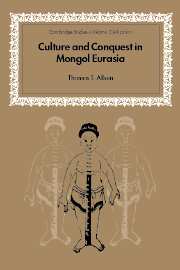Book contents
- Frontmatter
- Contents
- Preface
- Note on transliteration
- Abbreviations
- PART I BACKGROUND
- PART II POLITICAL–ECONOMIC RELATIONS
- PART III INTERMEDIARIES
- PART IV CULTURAL EXCHANGE
- 12 Historiography
- 13 Geography and cartography
- 14 Agriculture
- 15 Cuisine
- 16 Medicine
- 17 Astronomy
- 18 Printing
- PART V ANALYSIS AND CONCLUSIONS
- Bibliography
- Index
- Other titles in the series
16 - Medicine
Published online by Cambridge University Press: 04 September 2009
- Frontmatter
- Contents
- Preface
- Note on transliteration
- Abbreviations
- PART I BACKGROUND
- PART II POLITICAL–ECONOMIC RELATIONS
- PART III INTERMEDIARIES
- PART IV CULTURAL EXCHANGE
- 12 Historiography
- 13 Geography and cartography
- 14 Agriculture
- 15 Cuisine
- 16 Medicine
- 17 Astronomy
- 18 Printing
- PART V ANALYSIS AND CONCLUSIONS
- Bibliography
- Index
- Other titles in the series
Summary
The Mongols of the imperial era possessed an extensive repertoire of medical practices, cures, and materia medica; as in all folk traditions, their healing techniques were rooted in both empirical knowledge and spiritual–magical belief. Interestingly, Rashīd al-Dīn tells us that certain tribes had greater skill in this field than others, particularly the peoples of southern Siberia, who, he says, “well understand Mongolian medicines and well apply Mongolian cures.” Some of their medicines are known by name, qajir, for example, but nothing is known of their composition or character. In addition to their folk medicines, the Mongols also tried to harness the curative powers of mineral springs and the viscera of freshly killed animals which, if properly applied, were thought to heal various maladies and wounds. In later centuries at least, bloodletting was also an important part of their medical repertoire.
When they acquired empire and held sway over a vast territory and a multitude of peoples, the Mongolian ruling elite had access, of course, to the major medical systems of Eurasia – Chinese, Korean, Tibetan, Indian, Uighur, Muslim, and Nestorian Christian. Chinggisid princes soon acquired their personal physicians who traveled with them on administrative rounds and military campaigns. Qubilai, who suffered from gout, had a large contingent of healers in his traveling camp (orda). In some cases these medical retainers were simply conscripted like soldiers and artisans.
- Type
- Chapter
- Information
- Culture and Conquest in Mongol Eurasia , pp. 141 - 160Publisher: Cambridge University PressPrint publication year: 2001



